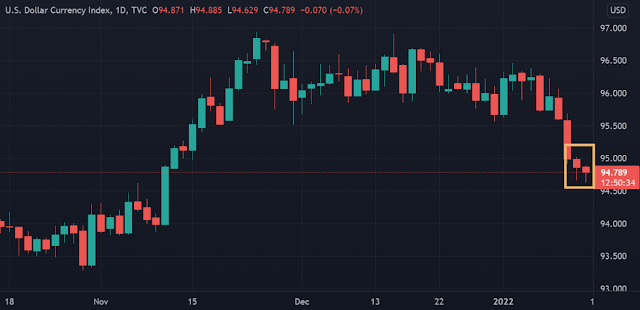There are concerns that Quantitative Tightening (QT) could limit the potential for the Fed's rate hikes.
The US dollar index (DXY) fell for the fourth day in a row to hit 94.62 in the mid-European session (14/January). Market participants initially indicated that the depreciation of the dollar was related to the hawkish attitude of the US Federal Reserve which had been fully factored into the greenback. However, a number of analysts assessed that the Fed's Quantitative Tightening (QT) plan might also contribute to the weakening of the US dollar this week.
 |
| DXY DailyDXY Daily Chart via TradingView |
The discourse on Quantitative Tightening surfaced in the minutes of the December 2021 FOMC meeting. The QT policy is contrary to Quantitative Easing (QE). Implementation of QE means that the central bank purchases bonds and other securities to increase the money supply, usually to boost inflation and stimulate the economy. Meanwhile, QT means that the central bank stops reinvesting of matured securities, or even starts selling bonds ("streamlining the central bank's balance sheet").
QT is a suitable policy to "cool" inflation growth that is too fast. In this case, QT is part of a tightening of the central bank's monetary policy and the end goal is almost the same as an increase in interest rates.
For the Federal Reserve, the push to raise interest rates will likely lessen once QT has been enacted. In fact, market participants are already obsessed with the potential for an ambitious "Fed rate hike". A number of analysts assess the gap may also underlie the dollar's recent sell-off.
"With tighter monetary policy on the horizon, market attention has turned to a possible reduction in the Fed's assets under management which currently stands at a total of $9 trillion, up from $4.2 trillion before the COVID-19 pandemic," said Jay H. Bryson. , Chief Economist at Wells Fargo Securities.
"Our basic assumption is that the Federal Reserve will announce a balance sheet streamlining at the September 2022 FOMC meeting, with the actual downsizing starting one month later in October."
Quantitative Tightening does not necessarily have a bearish impact on the US dollar exchange rate. As a form of monetary tightening, QT should have a bullish impact. However, the current uncertainty raises concerns that QT could limit the potential for the Fed's rate hike in 2023. Speculation may continue to grow as long as there is no immediate statement from Fed officials about whether QT will affect the trajectory of future rate hikes.
Post a Comment for "Dollar Is Getting Depressed, Allegedly Due to Quantitative Tightening "